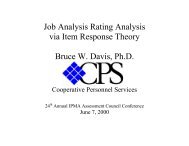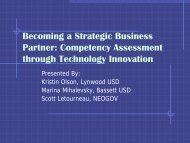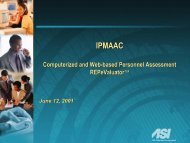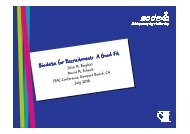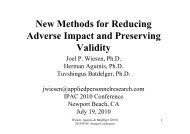An Introduction to Organizational Maturity Assessment - IPAC
An Introduction to Organizational Maturity Assessment - IPAC
An Introduction to Organizational Maturity Assessment - IPAC
You also want an ePaper? Increase the reach of your titles
YUMPU automatically turns print PDFs into web optimized ePapers that Google loves.
International Public<br />
Management<br />
Association<br />
<strong>Assessment</strong><br />
Council<br />
<strong>An</strong> <strong>Introduction</strong> <strong>to</strong> <strong>Organizational</strong><br />
<strong>Maturity</strong> <strong>Assessment</strong>:<br />
Measuring <strong>Organizational</strong> Capabilities<br />
Selena Rezvani, M.S.W.
Objectives<br />
�Define and describe an <strong>Organizational</strong><br />
<strong>Maturity</strong> Model (OMM)<br />
�Identify ways in which OMMs are developed<br />
and used<br />
�Identify areas of further study and<br />
advancement
What is a <strong>Maturity</strong> Model?<br />
� A collection of reliable, proven processes<br />
focused on a specific discipline<br />
� Five-step framework ranges from basic <strong>to</strong><br />
sophisticated practices<br />
� Organizations are objectively rated on a scale<br />
of 1-5 and given a score<br />
A roadmap for organizational improvement<br />
-adapted from © Carnegie Mellon University
Why Measure <strong>Organizational</strong> Processes?<br />
Measure<br />
Understand<br />
Control<br />
Improve<br />
If you can’t measure it, you can’t understand it.<br />
If you can’t understand it, you can’t control it.<br />
If you can’t control it, you can’t improve it.<br />
-James Harring<strong>to</strong>n<br />
The Improvement Process
Obstacles <strong>to</strong> <strong>Organizational</strong> Improvement<br />
� Best practices are not used<br />
� Investment in initiatives with little return on<br />
investment<br />
� Companies struggle <strong>to</strong> maintain capabilities<br />
amidst turnover, retirement, and succession<br />
Many Competency assessments exist that<br />
focus on the person… while organizational<br />
maturity assessments focus on practices<br />
and processes
A Brief His<strong>to</strong>ry of OMMs<br />
� Conceptual basis in quality improvement and process<br />
control<br />
� Software Engineering Institute developed a Capability<br />
<strong>Maturity</strong> Model ® for software engineering (early 1990s)<br />
� Today, maturity models address a wide range of <strong>to</strong>pics:<br />
– Project Management<br />
– Business <strong>An</strong>alysis<br />
– Knowledge Management<br />
– Branding<br />
– Product Development<br />
– Men<strong>to</strong>ring<br />
– Leadership<br />
– Risk Management<br />
– Personnel Management
Five Stage <strong>Maturity</strong> Model<br />
1<br />
Informal<br />
Ad hoc<br />
Initial<br />
Chaotic<br />
Inconsistent<br />
2<br />
Documented<br />
Emerging<br />
Managed<br />
Standardized<br />
Isolated<br />
Repeatable<br />
3<br />
Integrated<br />
Defined<br />
Structure<br />
Measured<br />
Competent<br />
4<br />
Strategic<br />
Aligned<br />
Disciplined<br />
Predictable<br />
Quantitatively<br />
managed<br />
5<br />
Optimized<br />
Adaptive<br />
Opportunistic<br />
Synthesized<br />
Proactive<br />
Agile
Approaches <strong>to</strong> OMMs<br />
� OMMs can either be staged or continuous<br />
– Staged: Lower level processes must be in place<br />
before higher levels can be attained<br />
– Continuous: Processes can be put in place at any<br />
time<br />
1<br />
2<br />
3<br />
4<br />
5
Effectiveness Evidence<br />
� Study of SEI’s<br />
software engineering<br />
maturity model<br />
effects<br />
(n=35 companies)<br />
� Median return on<br />
investment of 4:1<br />
Median improvements in:<br />
Cost 34%<br />
Schedule 50%<br />
Productivity 61%<br />
Quality 48%<br />
Cus<strong>to</strong>mer Satisfaction 14%
Benefits of OMMs<br />
� Inven<strong>to</strong>ry of current capabilities<br />
� Baseline for measuring improvement<br />
� Documents the need for change<br />
� Common language<br />
� Shared vision<br />
� Fosters a culture of excellence<br />
Sets the stage for organizational change
Situational Use of OMMs<br />
� Give <strong>to</strong>p leadership insight in<strong>to</strong> day<strong>to</strong>-day<br />
practices<br />
� Make informed decisions on<br />
workforce development & training<br />
� Focus attention on specific<br />
capabilities <strong>to</strong> be retained<br />
� Decide what new initiatives need <strong>to</strong><br />
be developed or launched<br />
� Inform suppliers/cus<strong>to</strong>mers about<br />
caliber of organization
Developing &<br />
Implementing<br />
an OMM
How are OMMs Developed?<br />
1. Identify a functional area, role or discipline<br />
2. Define a body of knowledge, including best<br />
practices, standards, and effective processes<br />
– Existing industry standards<br />
– Governmental guidance<br />
– Subject matter experts<br />
3. Develop the maturity model by defining key<br />
processes or components over 5 levels<br />
4. Implement the OMM through an assessment<br />
or consulting process<br />
5. Develop prioritized recommendations and<br />
document improvements
Implementation Process<br />
1. Introduce the assessment<br />
2. Collect and analyze data<br />
3. Develop findings and recommendations<br />
4. Implement recommendations<br />
5. Track organizational improvement<br />
Key considerations<br />
� Self-assessment versus an outside, or independent, assessment<br />
� Validated responses versus un-validated responses
Typical <strong>Maturity</strong> <strong>Assessment</strong> Timeline<br />
Week 1:<br />
Planning and Kickoff<br />
Identified 3-5<br />
representative<br />
projects<br />
Scheduled<br />
assessment<br />
activities<br />
Held kickoff<br />
meeting<br />
Week 2:<br />
Survey and Interviews<br />
Surveyed project<br />
management<br />
practices<br />
Validated results<br />
through<br />
interviews, focus<br />
groups, and<br />
archive reviews<br />
Built support for<br />
implementing<br />
recommendations<br />
Week 3:<br />
Findings and<br />
Recommendations<br />
Drafted,<br />
prioritized, and<br />
communicated<br />
findings<br />
Developed<br />
specific, tailored,<br />
actionable<br />
recommendations
Case Study:<br />
Project Management <strong>Maturity</strong><br />
� Award winning utility company<br />
� Not satisfied with current PM<br />
capability<br />
� Needed <strong>to</strong> improve PM <strong>to</strong> stay<br />
competitive<br />
� Tried <strong>to</strong> implement consistent PM<br />
practices for 3 years<br />
Before After<br />
• Reports entered<br />
in 12 different<br />
formats<br />
• Disjointed PM<br />
functions across<br />
units and levels<br />
• Documented the<br />
need for a single<br />
report management<br />
system<br />
• Stronger PMO<br />
that coordinates<br />
across units and<br />
levels<br />
� Identified PM practices they were<br />
doing right<br />
� Resulted in action plan <strong>to</strong> advance<br />
from Level 2 <strong>to</strong> Level 3
Areas for Further Advancement<br />
� Which disciplines lend themselves best <strong>to</strong> maturity models?<br />
� Which models are most effective at realizing value for the<br />
organization?<br />
� Will model ratings be used more widely as an industry<br />
benchmark?<br />
� Can abbreviated versions of OMMs be used?<br />
� Is it possible <strong>to</strong> develop a universal OMM?
Conclusion<br />
Measure twice, cut once!<br />
Ms. Selena Rezvani<br />
SRezvani@managementconcepts.com<br />
(703) 790-9595, x4025
Appendix: Six Sigma<br />
Six Sigma is different than organizational maturity and includes:<br />
� A clear focus on achieving measurable and quantifiable<br />
financial returns from any Six Sigma project.<br />
� <strong>An</strong> increased emphasis on strong and passionate management<br />
leadership and support.<br />
� A special infrastructure of "Champions", "Master Black Belts",<br />
"Black Belts" <strong>to</strong> lead and implement the Six Sigma approach.<br />
� A clear commitment <strong>to</strong> making decisions on the basis of<br />
verifiable data, rather than assumptions and guesswork.



